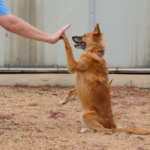Introduction
Understanding dog sleep patterns is crucial for fostering their overall well-being. Dogs, like humans, experience various sleep cycles, each serving a specific purpose in their physical and mental health. In this comprehensive guide, we will delve into the intricacies of doggy dreams, shedding light on their sleep habits and offering insights into ensuring your furry friend gets the rest they need.
The Science of Dog Sleep
Understanding the intricacies of a dog’s sleep stages is essential for responsible pet ownership. Dogs, like humans, experience distinct sleep cycles, each playing a crucial role in their physical and mental well-being.
Dogs go through two primary sleep stages: REM (Rapid Eye Movement) and non-REM sleep. During REM sleep, your dog may exhibit various behaviors, such as twitching, rapid eye movements, and even soft vocalizations. This stage is associated with dreaming and is essential for cognitive functions. Non-REM sleep consists of deeper, more restorative sleep, crucial for physical recovery.
Potential issues related to these sleep stages include disturbances that disrupt the natural progression. Factors like discomfort, noise, or inadequate sleep environments can impact the quality of your dog’s rest. Additionally, older dogs or those with certain medical conditions may experience alterations in their sleep patterns.
Practical solutions involve creating a comfortable sleep environment for your dog. Provide a cozy and quiet space with a suitable dog bed, ensuring it aligns with your dog’s size and preferences. Address external disturbances by minimizing noise and light in the sleeping area. For dogs with specific health conditions affecting sleep, consulting with a veterinarian is crucial to identify and manage underlying issues.
Common Sleeping Positions and What They Mean
Dogs communicate not only through barks and body language but also through their sleeping positions, offering insights into their comfort and emotional state. Understanding the various sleeping positions adopted by dogs allows pet owners to decode the messages behind each posture.
Common sleeping positions include the curled-up position, where a dog tucks its paws under its body, resembling a tight ball. This position reflects a dog’s need for warmth and security, often seen in colder environments. On the other hand, the sprawled-out position, with limbs extended in all directions, indicates a dog’s confidence and relaxation.
Potential issues related to sleeping positions can arise if a dog is consistently uncomfortable or unable to find a suitable sleeping spot. Challenges may include joint pain, anxiety, or environmental disturbances impacting the dog’s ability to assume certain positions comfortably.
Practical solutions involve creating a cozy and safe sleeping area tailored to your dog’s needs. Provide a variety of bedding options, such as soft cushions or blankets, allowing your dog to choose a comfortable spot. Regularly check for signs of discomfort or changes in sleeping habits, as these could indicate underlying health issues.
Sleep Disorders in Dogs
Understanding and addressing sleep disorders in dogs is crucial for their overall well-being. Dogs, like humans, can experience various sleep-related issues, and being aware of these challenges allows pet owners to provide proper care.
Common sleep disorders in dogs include insomnia, sleep apnea, and narcolepsy. Insomnia may result from factors such as anxiety, discomfort, or a lack of physical activity. Sleep apnea, characterized by interrupted breathing during sleep, can affect a dog’s quality of rest. Narcolepsy, although rare, causes sudden and uncontrollable episodes of sleep.
Identifying potential challenges related to sleep disorders involves observing changes in your dog’s sleep patterns, such as restlessness, excessive daytime sleepiness, or unusual behaviors during sleep. These signs may indicate an underlying sleep disorder that requires attention.
Practical solutions to address sleep disorders in dogs include maintaining a consistent sleep routine, providing a comfortable and quiet sleeping environment, and ensuring regular exercise to reduce anxiety and restlessness. If symptoms persist, consulting with a veterinarian is essential to rule out any underlying health issues.
Creating a Comfortable Sleep Environment
Ensuring that your canine companion has a comfortable sleep environment is vital for their overall well-being. Dogs, much like humans, benefit from a restful and secure space to recharge and thrive.
Potential challenges in creating an optimal sleep environment for dogs can include factors such as inappropriate bedding, excessive noise, or uncomfortable temperatures. It’s essential to observe your dog’s behavior and identify any signs of discomfort during sleep, such as restlessness or frequent waking.
To address these challenges, consider providing a cozy and appropriately sized bed for your dog. Choose bedding materials that suit their breed, size, and preferences, whether it’s a plush cushion, orthopedic mattress, or cooling pad. Additionally, placing the bed in a quiet and secluded area can help minimize disturbances.
Temperature control is another crucial aspect. Dogs are sensitive to extremes in temperature, so ensure the sleep space is neither too hot nor too cold. In colder weather, provide warm blankets, and during warmer seasons, ensure proper ventilation.
Addressing potential noise issues involves finding a quiet location for your dog’s bed, away from household commotion or external disturbances. This allows them to enjoy uninterrupted sleep, contributing to their overall health and happiness.
Dreaming and Nightmares in Dogs
Interpreting your dog’s dreams can be a delightful way to understand their inner world, but recognizing signs and distinguishing between a normal dream and a potential nightmare is essential for their well-being.
Typical signs that your dog is dreaming include twitching, paw movements, and soft vocalizations. These behaviors indicate that your dog is likely experiencing a regular dream, which is a natural part of their sleep cycle. However, it’s crucial to differentiate these from signs of distress during a potential nightmare.
Challenges may arise when dog owners misinterpret normal dreaming as a sign of distress. In some cases, dogs may display more intense behaviors, such as excessive whining, barking, or sudden waking with signs of fear. Identifying these signs is crucial in addressing any potential anxiety or discomfort.
To address these challenges, it’s essential to observe your dog’s overall behavior and identify patterns. If your dog consistently shows signs of distress during sleep, consider consulting with a veterinarian to rule out any underlying health issues. Additionally, creating a calm and secure sleep environment can contribute to more restful dreams.
Conclusion
Decoding your dog’s sleeping patterns is an essential aspect of responsible pet ownership. By understanding the science behind their sleep, recognizing potential issues, and creating a conducive sleep environment, you can contribute to your dog’s overall health and happiness. Paying attention to these nuances enhances the bond between you and your furry companion, ensuring they enjoy restful nights filled with sweet dreams.









